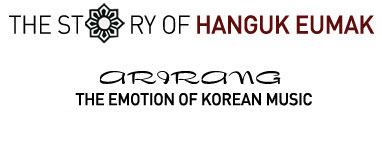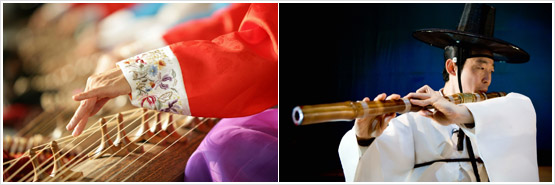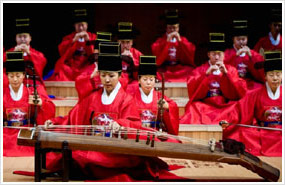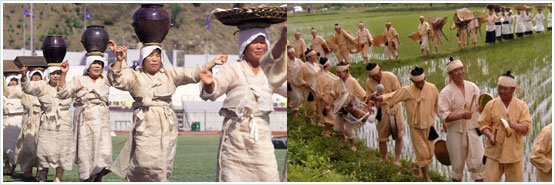|
The burning of the heart is implicit in the sound of the voice. This is the first step of being able to understand traditional Korean music. Within traditional Korean music listeners can find the history of the Koreans, a history memorable for its sorrow and pain. Much of the music that has been passed down from previous generations deals with feeling of separation. Koreans sang songs when they could not hold their sadness in.
Of course, not all Korean music is sad. For example, royal court music is a kind of music used for ceremonies or rituals. Music played during religious services or events belongs to this category. Consequently, formal music often focuses on lauding If formal music is for the ruling class then 'folk music' is the song of those being ruled. This genre includes the pansori, a traditional Korean narrative song, which has been named a UNESCO world intangible heritage. The pansori is a kind of music presented to audiences by skilled vocal singers and drummers. But even the unskilled could sing these songs. They sang when they worked in the rice paddy or fields, sang when they went off their lover and sang when their life was troubled and weighing them down. The 'folk song' literally means the song of folklore. Therefore, the folk song is the traditional music sung most frequently by Koreans.
Traditional Korean music Is significantly different from that of other places. In Western music for instance, one note equals one beat. In the meter of Korean music, however, is one that phrase gets one breath. Basically, the unit of times for rhythm is different between Korea and other countries. More interestingly, there is no conductor for Korean music. The individual musicians of a group must play his or her instrument in tune with his breath and with the breath of his or her colleague's. The breath of Korean musical rhythm unites with movement. The traditional Korean music is always accompanied by dance and song. For a greater depth of view of Korean music, focus must be given to the breath of the musicians. The Korean expression 'tuning the breath' originates from the concept of rhythm in Korean music. |
| [Types of Traditional Music and Listening to Sample Music] |
| * “Sujecheon”, a piece of instrumental music performed at the royal court: To hear the sample music * “Jeonpyehoemun”, a music piece played during events at the royal court: To hear the sample music * “Ujosamsudaeyeop”, songs with lyrics from poetry by noblemen or scholars: To hear the sample music |
|
| A performance of the gayageum , a string instrument often played by noble women as a part of their cultural education or by lady entertainers Source : visitkorea.or.kr |
13 September 2011
Hanguk Eumak Music
Subscribe to:
Post Comments (Atom)



 the achievements of past kings. The strict format is more important than the content in the case of music played for official events. The display and playing of every instrument is also symbolic. One typical example of formal Korean music is the Jongmyo Shrine ritual music. It is the music that is played for the ritual services for former kings and has been appointed a world intangible heritage by UNESCO.
the achievements of past kings. The strict format is more important than the content in the case of music played for official events. The display and playing of every instrument is also symbolic. One typical example of formal Korean music is the Jongmyo Shrine ritual music. It is the music that is played for the ritual services for former kings and has been appointed a world intangible heritage by UNESCO.

No comments:
Post a Comment